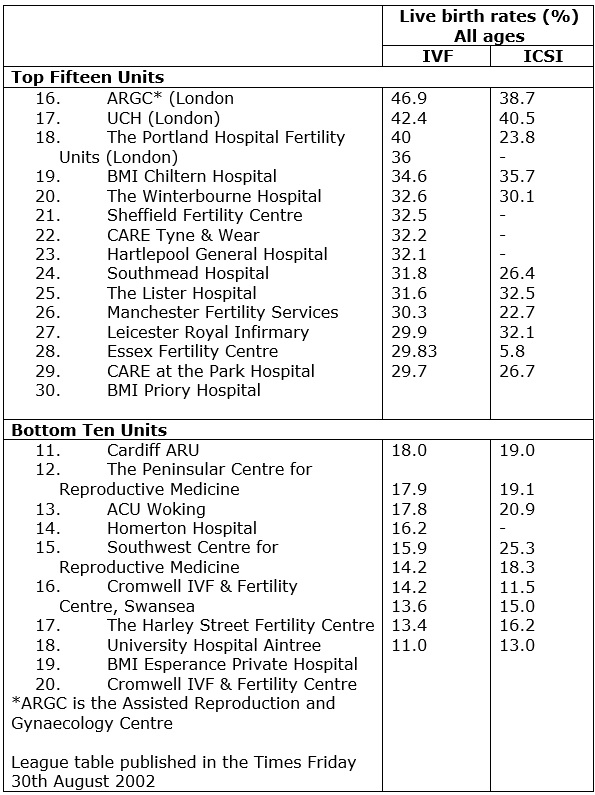
Search our library
Menu
How Useful Are League Tables?
Since 1991, almost every year, the HFEA has published data from IVF clinics. This data has then been used by newspapers to assemble a league table, which has been used by many patients as an aid to choosing their clinic. Almost every unit has declared the league tables to be unhelpful. Nevertheless, it proves irresistible for many would-be patients. We try here to address the usefulness of the league table as a guide for choosing an IVF unit. Please note the HFEA has its own FAQ on this matter, which may be found here http://www.hfea.gov.uk/index.html.
What do the statistics show?
The top three units in the country have a live birth rate (LBR) for IVF of 40% or more. Statistically, these top three units are only better than the bottom five units! The units ranked 4th to 15th are not statistically better than the units ranked 1 to 5 in the bottom ten. The league table, therefore, is actually of little use in telling us whether units are truly better than each other.
What factors can influence the statistics?
A possible factor to consider is the use of donor sperm or eggs in IVF. In my experience, donor IVF gives 30-35% live birth rates irrespective of the female partner`s age, especially with donor eggs. In my opinion, a good unit might achieve a 20% live birth rate with patients (using their own sperm and eggs) with an average female partner age of 35 years. So, if this unit did 300 cycles a year, there would be 60 live births. If the unit suddenly decided to switch 150 of those 300 cycles to donor cycles, there would be 52 live births. At 20% the remaining 150 cycles would yield 30 live births. Therefore overall the live birth rate would be 27%, which would significantly boost the unit`s placing in the league table. The age of the female partner is also an issue. Success rates would be higher with younger women. Moreover, it is unclear whether all units are returning data in the same way to the HFEA. The data is actually returned by the units themselves and not subjected to any validatory procedure!
How to choose?
I hope it becomes clear that the league table should only be used as a rough guide. Certainly, if you live in London and have visited a number of the units, and find them all much the same and you find the prices of the units pretty similar, it would be reasonable to base your final choice on location. If there is a much lower placed unit in your own locality, perhaps this would be a better option, as opposed to a top ten unit, which is miles away from your own home (the stress of travelling should not be underestimates). If you lived in the Midlands, you would do just as well to choose a top fifteen unit and be treated locally as opposed to coming to London for one of the top three units. Especially as there is absolutely no proof whatsoever that the top three units are better than any of the others in the top fifteen. In a nutshell, rely on your own initiative and instincts. Visit your local clinics. Ask questions, seek sympathetic units. Then weigh up where they are in the league table. Only seek to travel further afield if your local units are in the bottom fifteen and you are dissatisfied with their response to your questions. Then seek the nearest centres with acceptable results (20-25% live birth rates or better). I hope this information is useful. Good luck.
Sammy Lee
The HFEA now provide data, which covers information in the following way:
- Whether the clinic’s success rate is above, below or consistent with the national average success rate across all clinics
- The actual number of treatment cycles a clinic carried out and how many of those cycles resulted in a live birth
- The predicted chance of an average woman having a live birth if she was treated at a clinic
More about the way the HFEA now present data can be found at: http://www.hfea.gov.uk/fertility-clinics-success-rates.html
A Sample League Table
